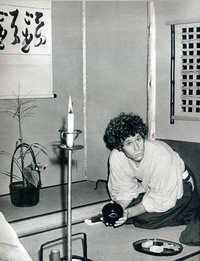|
|
|
|
|
|
|
|
|
|
||||||||||
|
|
||||||||||
|
|

Early History in Kyoto
The history of Origin goes back to 1976, when a group of visionaries created the Oomoto School of Traditional Japanese Arts at the Oomoto Foundation outside of Kyoto. The founders included art collector David Kidd, Mme Naohi the Spiritual Leader of Oomoto, Dean James Parks Morton of the Cathedral of St John the Divine in New York, and Buckminster Fuller. This school was the first attempt to teach all the Japanese arts in a unified way in a beautiful context — and over the next 20 years, it produced hundreds of alumni across the world, whose lives were transformed by the experience.
During those two decades we developed a unique approach to teaching the arts to modern people. I worked as manager of the Oomoto School since its inception, and after it closed in 1997, it was my dream to revive it in new guise, not only in Japan, its birthplace, but in other Asian nations as well, such as Thailand. It took eight years, but finally in 2005, the Origin Program is born.
The Oomoto School

|
David Kidd's Dream The following quotation is from an interview with David Kidd in the 1980's. It captures something of the feeling that inspired the Omoto School and now the Origins Program. I am in a burning house. It is the inner mansion of some Chinese palace. It seems to be a library or a study, a repository of some sort. Towering shelves bearing countless ancient scrolls line the walls. The furniture in the room, made from the wood of an extinct kind of tree, is actually perspiring. The roar of the flames is growing. At the end of the room are a pair of elaborate decorative shelves. They are of exquisite lacquer with mother-of-pearl inlay. On each of the shelves is a carved shape of white jade, unrecognizable figures of unspeakable refinement. |
Tea ceremony class, 1976

David kidd
|
|
|
|
|
|


